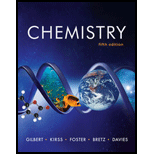
(a)
Interpretation: The balanced equation for the cell reaction for each of the given pairs is to be stated. The identification of the half reaction at each anode and cathode is to be done.
Concept introduction: The half cell in which oxidation takes place is known as anode and the half cell at which reduction takes place is called cathode.
To determine: The balanced equation for the cell reaction for each of the given pair and the identification of the half reaction at each anode and cathode.
(a)
Answer to Problem 18.38QP
Solution
The balanced equation for the cell reaction for each of the given pair is shown in equation (5). The half reaction at anode is shown in equation (3) and the half reaction at cathode is shown in equation (4).
Explanation of Solution
Explanation
The given pair is,
The standard reduction potentials are,
Equation (1) has more
Multiply equation (2) by
Add equation (3) and (4) to get the balanced equation.
The half reaction at anode is shown in equation (3) and the half reaction at cathode is shown in equation (4).
(b)
To determine: The balanced equation for the cell reaction for each of the given pair and the identification of the half reaction at each anode and cathode.
(b)
Answer to Problem 18.38QP
Solution
The balanced equation for the cell reaction for each of the given pair is shown in equation (10). The half reaction at anode is shown in equation (8) and the half reaction at cathode is shown in equation (7).
Explanation of Solution
Explanation
The given pair is,
The standard reduction potentials are,
Reverse the equation (6) to get positive value of
Multiply equation (8) by
Add equation (7) and (9) to get the balanced equation.
The half reaction at anode is shown in equation (8) and the half reaction at cathode is shown in equation (7).
(c)
To determine: The balanced equation for the cell reaction for each of the given pair and the identification of the half reaction at each anode and cathode.
(c)
Answer to Problem 18.38QP
Solution
The balanced equation for the cell reaction for each of the given pair is shown in equation (15). The half reaction at anode is shown in equation (13) and the half reaction at cathode is shown in equation (11).
Explanation of Solution
Explanation
The given pair is,
The standard reduction potentials are,
Reverse the equation (12) to get positive value of
Multiply equation (13) by
Add equation (11) and (14) to get the balanced equation.
The half reaction at anode is shown in equation (13) and the half reaction at cathode is shown in equation (11).
Conclusion
The balanced equations for the cell reaction for each of the given pairs have been stated
Want to see more full solutions like this?
Chapter 18 Solutions
Smartwork5 Printed Access Card for Use with Chemistry: The Science in Context 5th Edition (SmartWork Access Printed Access Card)
 ChemistryChemistryISBN:9781305957404Author:Steven S. Zumdahl, Susan A. Zumdahl, Donald J. DeCostePublisher:Cengage Learning
ChemistryChemistryISBN:9781305957404Author:Steven S. Zumdahl, Susan A. Zumdahl, Donald J. DeCostePublisher:Cengage Learning ChemistryChemistryISBN:9781259911156Author:Raymond Chang Dr., Jason Overby ProfessorPublisher:McGraw-Hill Education
ChemistryChemistryISBN:9781259911156Author:Raymond Chang Dr., Jason Overby ProfessorPublisher:McGraw-Hill Education Principles of Instrumental AnalysisChemistryISBN:9781305577213Author:Douglas A. Skoog, F. James Holler, Stanley R. CrouchPublisher:Cengage Learning
Principles of Instrumental AnalysisChemistryISBN:9781305577213Author:Douglas A. Skoog, F. James Holler, Stanley R. CrouchPublisher:Cengage Learning Organic ChemistryChemistryISBN:9780078021558Author:Janice Gorzynski Smith Dr.Publisher:McGraw-Hill Education
Organic ChemistryChemistryISBN:9780078021558Author:Janice Gorzynski Smith Dr.Publisher:McGraw-Hill Education Chemistry: Principles and ReactionsChemistryISBN:9781305079373Author:William L. Masterton, Cecile N. HurleyPublisher:Cengage Learning
Chemistry: Principles and ReactionsChemistryISBN:9781305079373Author:William L. Masterton, Cecile N. HurleyPublisher:Cengage Learning Elementary Principles of Chemical Processes, Bind...ChemistryISBN:9781118431221Author:Richard M. Felder, Ronald W. Rousseau, Lisa G. BullardPublisher:WILEY
Elementary Principles of Chemical Processes, Bind...ChemistryISBN:9781118431221Author:Richard M. Felder, Ronald W. Rousseau, Lisa G. BullardPublisher:WILEY





